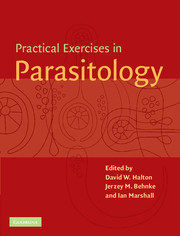Book contents
- Frontmatter
- Contents
- List of contributors
- Preface
- General advice
- 1 Observational Exercises on Parasites
- 2 Ecology
- 3 Physiology and Biochemistry
- 4 Pathology and Immunology
- 5 Chemotherapy
- 6 Molecular Parasitology
- 7 Behaviour
- 7.1 Behaviour of the miracidia of Fasciola hepatica and demonstration of other larval stages
- 7.2 Effects of age and environmental factors on the swimming behaviour of the cercariae of Cryptocotyle lingua (Trematoda)
- 7.3 Changes in host behaviour as a consequence of parasite infection
- 7.4 Behaviour of the amphipod Gammarus pulex, infected with cystacanths of acanthocephalans
- 7.5 Effects of Schistocephalus solidus (Cestoda) on stickleback feeding behaviour
- Appendix 1 Reagent index
- Appendix 2 UK suppliers
- Appendix 3 US suppliers
- Index
7.4 - Behaviour of the amphipod Gammarus pulex, infected with cystacanths of acanthocephalans
Published online by Cambridge University Press: 05 June 2012
- Frontmatter
- Contents
- List of contributors
- Preface
- General advice
- 1 Observational Exercises on Parasites
- 2 Ecology
- 3 Physiology and Biochemistry
- 4 Pathology and Immunology
- 5 Chemotherapy
- 6 Molecular Parasitology
- 7 Behaviour
- 7.1 Behaviour of the miracidia of Fasciola hepatica and demonstration of other larval stages
- 7.2 Effects of age and environmental factors on the swimming behaviour of the cercariae of Cryptocotyle lingua (Trematoda)
- 7.3 Changes in host behaviour as a consequence of parasite infection
- 7.4 Behaviour of the amphipod Gammarus pulex, infected with cystacanths of acanthocephalans
- 7.5 Effects of Schistocephalus solidus (Cestoda) on stickleback feeding behaviour
- Appendix 1 Reagent index
- Appendix 2 UK suppliers
- Appendix 3 US suppliers
- Index
Summary
Aims and objectives
This exercise is designed to demonstrate:
That a parasite can alter the behaviour of its intermediate host to make it more vulnerable to predation by its definitive host.
For students, this exercise aims to:
Demonstrate the influence of a parasite on the behaviour of its intermediate host in order to complete its life cycle.
Facilitate the design of experiments and formulation of conclusions on the strategies employed by parasites to complete their life cycle.
Encourage understanding about studies that might be conducted in the laboratory and in the field to study the manipulation of host behaviour by parasites.
Examine a facet of biology embracing the fields of parasitology and animal behaviour.
Introduction
Over the past two decades, exciting developments have been made in understanding the coevolution and coexistence of parasites and their hosts (e.g. Moore, 1995). One of the most intriguing areas of host-parasite ecology is the ability of parasites to change the appearance and/or behaviour of one (intermediate) host to facilitate transmission to another (definitive) host.
This practical exercise describes experiments applicable to an association between a parasite and its two hosts. The experiments are designed to explore morphological and behavioural changes in the intermediate host that facilitate transmission of the parasite to the definitive host. Specifically, we are concerned with the effects of an acanthocephalan parasite on the behaviour of shrimps (gammarids), and then predation by its definitive host-fish (Fig. 7.4.1).
- Type
- Chapter
- Information
- Practical Exercises in Parasitology , pp. 423 - 432Publisher: Cambridge University PressPrint publication year: 2001



